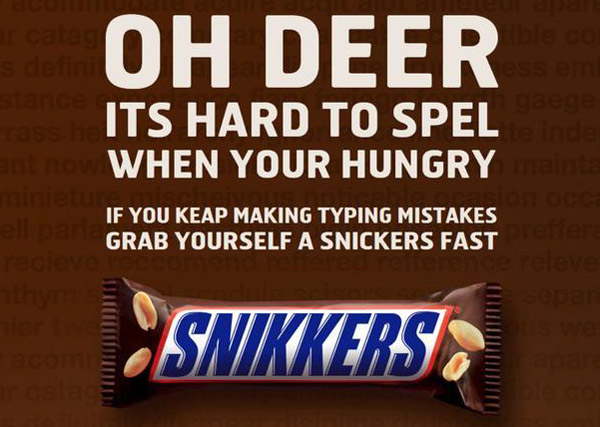What is disruption?
It’s breaking the normal rules. Like when ads find a different way to engage us (Compare the Meerkat is the now-classic example), set out to shock us, or make deliberate mistakes like the Snickers example below.
It’s creating something new that changes the rules. Like how the first iPhone, which looked and worked completely differently to anything before it, changed the phone market overnight.
Disruption works by challenging our usual thought processes. It gets our attention by raising lots of questions – What is going on here? Is this better or worse than the standard way of doing things?

Getting a customer’s attention is obviously a good thing. In fact, it’s the first goal of pretty much every marketing campaign!
And, when our thoughts are disrupted, we’re more open to suggestion. We’ve had our feathers ruffled — now we need answers, guidance so we can decide how to feel about these new ideas.
This is the point where a disruptive advert can also persuade very successfully.

The disrupt-then-reframe technique (DTR)
So, how can you use disruption in your copywriting?
Thankfully you don’t need to invent a new product every time. You can present an existing idea in a new way, with the disrupt-then-reframe technique of social influence.
DTR was most famously demonstrated by Barbara Davis and Eric Price in the Journal of Personality and Social Psychology, with one simple experiment.
They sold note cards door-to-door with two different sales pitches:
- The first pitch offered “8 cards for $3“.
- The second pitch presented the price as “300 pennies for 8 cards… which is a bargain!“
Both pitches offered the same price. Both used short and simple wording. But I’m sure you can guess which one sold twice as many note cards.
The “300 pennies for 8 cards” part disrupts the customer’s thought process. Its surprising price presentation asks us to do a bit of arithmetic.
The second part, “…which is a bargain!”, is the reframe – a new representation of the product, which the earlier disruption makes us open to.
It needs to be challenging
One very important point about disrupt-then-reframe. The disruption needs to be something that’s slightly tricky for our brains to think about (like the arithmetic in the Davis and Price experiment).
This is how you get people scratching their heads, challenge their ideas and — as a result — open them up to persuasion.
So, it’s…
- Disrupt the customer’s normal thought processes with a challenging idea – something distracting that makes people think.
- Reframe your offering as the best answer.
Need some help? Leave a comment or ask us.
Featured image: “Fruit Cart” by Paul Hamilton is licensed under the Creative Commons Attribution-Share Alike 2.0 Generic license.

